Top ML Announcements From Microsoft Build 2021
“Azure ML Managed Endpoints is already being used for the OpenAI GPT-3 model.”
Microsoft kicked off its annual developer’s conference, Microsoft Build. The event, which will be held digitally for the second time in a row, had a jam-packed first day where multiple announcements within various facets of Microsoft, from MS Teams to Azure, were made. Here is a round-up of key announcements and releases related to artificial intelligence and machine learning.
AI for Azure
Build 2021 made many AI-related updates to Azure, Microsoft’s cloud computing platform. Azure’s AI service involves a portfolio of AI services for data scientists and developers to deploy their own AI solutions. The portfolio includes ML models with tools such as Jupyter Notebook and open-source models like PyTorch and TensorFlow. Microsoft has also announced two key machine learning capabilities to help customers deploy AI models with ease.
The first of these is called Azure Machine Learning Managed Endpoints, which is currently in preview. This novel capability would allow developers and data scientists to build and deploy ML models quickly and easily. The model automates the creation and management of the underlying compute infrastructure, which includes updates and security features. Through this, users can get access to out-of-the-box infrastructure monitoring and log analytics capabilities.
Azure ML Managed Endpoints is already being used for the OpenAI GPT-3 model, which is among the world’s most significant natural language models—in Microsoft Power Apps. Microsoft announced its use of the OpenAI GPT-3 model to generate Power Fx formulas based on natural language input automatically. As per Satya Nadella’s keynote announcement, this is being added to the Power Apps Studio. Users can leverage GPT-3 to translate their queries in natural language into usable Power Fx Code. For instance, instead of learning how to write database queries in Power Fx, the user could write ‘Show 10 orders with ABC in their product name and sort by date with oldest on top’, and the AI will produce the corresponding code for them. This way, Power Apps users will be able to build apps more quickly and efficiently.
Conversational AI
A slew of improvements has been made to Azure’s Bot Service and Bot Framework, including releasing a new model: Bot Framework Composer 2.0. The service provides an integrated, purpose-built environment for bot development. It includes a visual authoring canvas with open-source tools to enable developers to add speech and telephony features and help them test, debug, and publish bots to multiple channels with minimal code changes. Also, updates have been added to make the bot service more secure with the introduction of Customer Managed Encryption Keys—which would allow the data stored about the bot to be encrypted by a Microsoft-managed key and a key provided by the user.
The Bot Framework Composer is Microsoft’s open-source integrated development tool for writing conversational AI applications. Its 2.0 version would feature new templates to pose as starting points for your bots. Composer 2.0 will also guide the user as they begin to build their application. These tools would also make publishing bots to Azure easier with integrated resource provisioning and publishing from within the Composer.
Azure Metrics Advisor
In September 2020, Microsoft announced its plans for the Azure Metrics Advisor—which was inspired by their work in detecting deviations from normal operations within the Bing search engine. At Build 2021, the tech giant announced that the AI-powered platform is now generally available. The service, which is tailored for businesses, will take in time-series data and use machine learning to detect anomalies from sensors, products and metrics automatically. The algorithm used will also provide diagnostic insights and allow users to monitor their organisation’s performance with ease (without themselves needing to be experts of machine learning).
Azure Video Analyser
Another new service is the Azure Video Analyser. This service, like the Metrics Adviser, also looks for anomalies using AI. It uses existing services such as the Computer Vision from Azure Cognitive Services to build AI-powered video analytics from both stores and streaming footage. According to Microsoft, this brings Live Video Analytics and Video Indexer into a single service. The former would help build intelligent, video-based apps using the user’s choice of AI. At the same time, the Indexer automatically extracts data from video and audio content. Customers can use this for workplace safety, digital asset management, and monetising content.
The Azure Bot Service, Metrics Advisor and Video Analyser—along with Azure Cognitive Search, which would bring an AI-backed cloud search to mobile and web apps, and Azure Form Recogniser, which would enable quickly turning documents into usable data—will all be making up a new category within Azure AI called Azure Applied AI Services. These services build on the cognitive APIs from Azure Cognitive Services and Azure Machine Learning. Doing so, as per Microsoft, provides it with task-specific AI and built-in business logic, allowing it to develop AI-powered business solutions further.
Azure Cognitive Services
Further updates in AI fall under the Azure Cognitive Services, which are another collection of AI services and cognitive APIs to help users build intelligent applications. Microsoft Build 2021 brought in enhancements for these products, especially Document Translation and Text Analytics for Health.
Document Translation
Document Translation, which was announced in February, is now available. This feature allows developers to translate documents while preserving the structure and format of the original document. The AI-delivered feature could quickly perform tasks for enterprises that require going through complex documents in one or more languages.
Text Analytics for Health
Now generally available with Text Analytics in Azure Cognitive Services, this would quickly process and derive insights from unstructured medical data. Such data includes doctors’ notes, medical journals, clinical trial protocols, and electronic health records. An additional feature of Text Analytics is called Question Answering, which will allow users to find answers from text passages without needing to save or manage data in Azure.
.
Finally, Microsoft is bringing PyTorch Enterprise to Azure, which would provide additional benefits to users of Microsoft Premier and Unified Support for Enterprise. These benefits include hands-on support and solutions to bugs and security patches. Microsoft users with Microsoft Premier and Unified Support using PyTorch will be eligible for PyTorch Enterprise and will be able to request hotfixes.
Stay tuned to Analytics India Magazine for more updates from Microsoft BUILD 2021
The post Top ML Announcements From Microsoft Build 2021 appeared first on Analytics India Magazine.




